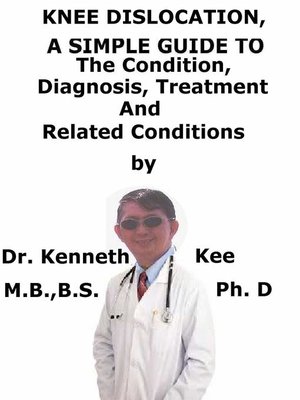Knee Dislocation, a Simple Guide to the Condition, Diagnosis, Treatment and Related Conditions
ebook
By Kenneth Kee

Sign up to save your library
With an OverDrive account, you can save your favorite libraries for at-a-glance information about availability. Find out more about OverDrive accounts.
Find this title in Libby, the library reading app by OverDrive.



Search for a digital library with this title
Title found at these libraries:
| Library Name | Distance |
|---|---|
| Loading... |
This book describes Knee Dislocation, Diagnosis and Treatment and Related Diseases
A knee dislocation occurs more specifically when the bones of the leg (the tibia and fibula) are shifted in relation to the bone in the thigh (femur).
The bones of the knee are kept together by strong bands of tissue called ligaments.
Each ligament is accountable for stabilizing the knee in a certain position.
For a knee dislocation to happen, these ligaments must tear.
A partial dislocation is called a subluxation.
In some injuries, the kneecap (patella) and its ligaments are also dislocated.
Improper or delayed treatment of a knee dislocation may cause the loss of the leg.
If the patient dislocates the knee, it means that the bones that come together at that joint have been forced out of place with great force.
It is an emergency and it is very painful.
Dislocated knees are rare, but they are serious.
A knee dislocation is unlike a patellar dislocation in which only the kneecap is detached from its groove at the end of the femur.
Causes
Knee dislocations are often the effect of a high-impact injury such as an automobile accident, severe or hard fall, and sports injuries.
Symptoms
There is a history of trauma and deformity of the knee.
There is knee pain and instability of the knee joint.
When the patient dislocates the knee, the patient may hear a popping sound.
These symptoms also are frequent:
1. Pain: It hurts a lot. The knee is in so much pain that the patient cannot move it.
2. Swelling: It is swollen and severely bruised.
3. Deformity: Parts of the knee look like they have been knocked out of place.
The most frequent symptoms of knee dislocation are the visible swelling and deformity of the knee joint
Appearance
a. No obvious deformity
50% of knee dislocations spontaneously reduce before arrival to ED
Knee dislocations may present with subtle signs of trauma (swelling, effusion, abrasions, ecchymosis)
b. Obvious deformity
The doctor should reduce immediately, especially if absent pulses are present.
"Dimple sign"- is the buttonholing of medial femoral condyle through the medial capsule.
This is an indicative of an irreducible posterolateral knee dislocation.
It is a contraindication to closed reduction due to risks of skin necrosis.
The lower extremity will often appear shortened and misaligned, and any movement of the joint will produce extreme pain.
Vascular examination
The priority is to exclude vascular injury on knee exam both before and after reduction
The doctor should palpate the dorsalis pedis and posterior tibial pulses on injured and contralateral side.
1. If pulses are present and normal:
It does not indicate the absence of arterial injury.
The Ankle-Brachial Index (ABI) is measured on all patients with suspected KD
The test compares the blood pressure at the ankle with the blood pressure at the arm.
a. If ABI >0.9
The doctor does serial examination (100% Negative Predictive Value)
b. If ABI







